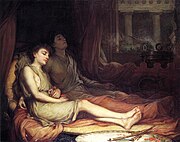John William Waterhouse
From Wikipedia, the free encyclopedia
| This article does not cite any references or sources. Please help improve this article by adding citations to reliable sources (ideally, using inline citations). Unsourced material may be challenged and removed. (November 2007) |
| John William Waterhouse | |
 John William Waterhouse, working on "Lamia", circa 1908-09. |
|
| Born | April 6, 1849 Rome, Italy |
| Died | 10 February 1917 (aged 67) London, England |
| Nationality | British |
| Field | Painter |
| Training | Royal Academy |
| Movement | Pre-Raphaelite |
| Works | Hylas and the Nymphs The Lady of Shalott Ophelia |
| Influenced by | Lawrence Alma-Tadema Frederic Leighton |
John William Waterhouse (6 April 1849 — 10 February 1917) was an English Pre-Raphaelite painter most famous for his paintings of female characters from mythology and literature. He belonged to the later phase of the Pre-Raphaelite Brotherhood.
Contents |
[edit] Early life
He was born in Rome to the painters William and Isabela Waterhouse, but when he was five the family moved to South Kensington, near the newly founded Victoria and Albert Museum. He studied painting under his father before entering the Royal Academy schools in 1870. His early works were of classical themes in the spirit of Alma-Tadema and Frederic Leighton, and were exhibited at the Royal Academy, the Society of British Artists and the Dudley Gallery.
[edit] Later career
In 1874, at the age of twenty-five, Waterhouse submitted the classical allegory Sleep and His Half-Brother Death to the Royal Academy's Summer Exhibition. The painting was very well received and he exhibited at the RA almost every year afterwards until his death in 1917. In 1883 he married Esther Kenworthy, the daughter of an art schoolmaster from Ealing who had exhibited her own flower-paintings at the Royal Academy and elsewhere. They had two children, but both died in childhood. In 1895 Waterhouse was elected to the status of full Academician. He taught at the St. John's Wood Art School, joined the St John's Wood Arts Club, and served on the Royal Academy Council.
One of Waterhouse's most famous paintings is The Lady of Shalott, a study of Elaine of Astolat, who dies of grief when Lancelot will not love her. He actually painted three different versions of this character, in 1888, 1894, and 1916. Another of Waterhouse's favorite subjects was Ophelia; the most famous of his paintings of Ophelia depicts her just before her death, putting flowers in her hair as she sits on a tree branch leaning over a lake. Like The Lady of Shalott and other Waterhouse paintings, it deals with a woman dying in or near water. He also may have been inspired by paintings of Ophelia by Dante Gabriel Rossetti and Millais. He submitted his Ophelia painting of 1888 in order to receive his diploma from the Royal Academy. (He had originally wanted to submit a painting titled "A Mermaid", but it was not completed in time.) After this, the painting was lost until the 20th century, and is now displayed in the collection of Lord Andrew Lloyd-Webber. Waterhouse would paint Ophelia again in 1894 and 1909 or 1910, and planned another painting in the series, called "Ophelia in the Churchyard."
Waterhouse could not finish the series of Ophelia paintings because he was gravely ill with cancer by 1915. He died two years later, and his grave can be found at Kensal Green Cemetery in London.
[edit] Gallery
[edit] 1870s
[edit] 1880s
[edit] 1890s
[edit] 1900s
[edit] 1910s
[edit] See also
[edit] External links
| Wikimedia Commons has media related to: John William Waterhouse |
- John William Waterhouse (The Art and Life of JW Waterhouse);
- John William Waterhouse (Comprehensive Painting Gallery)
- "J.W. Waterhouse: The Modern Pre-Raphaelite": information about the upcoming exhibition 2008-2010
- Galleries Guide to Waterhouse Works Worldwide
- Waterhouse at Tate Britain
- Echo and Narcissus (1903)
- John William Waterhouse at artrenewal.org
- Ten Dreams Galleries
- John William Waterhouse in the "History of Art"
- Scent and femininity in John William Waterhouse's "The Soul of the Rose"
- Hundreds of images by the artist online.
[edit] References
- Benezit, E. (2006). Waterhouse, John William. In Dictionary of Artists (Vol 14, pp 668-669). Paris:Grund.
- Trippi, P. (2002). J.W.Waterhouse. New York, NY: Phaidon Press Limited.






























































